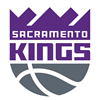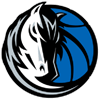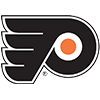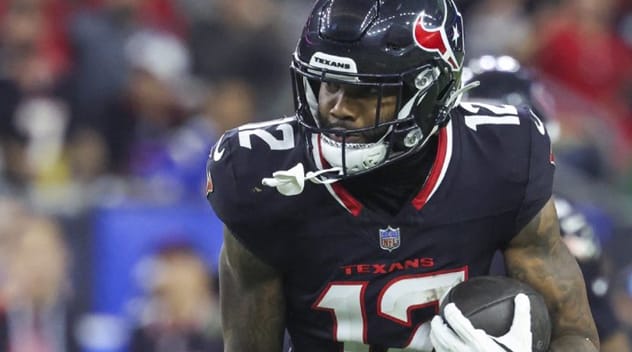The big tournaments dominate discussion and content related to NFL best ball, as has always been the case with DFS. That's certainly been true for my best ball articles this summer, with previous iterations discussing playoff strategy (Weeks 15-17), cheap stacks and ADP inconsistencies between sites.
The last one applies to both tournaments and smaller contests, but now it's time to focus strictly on the 12-player leagues, which typically play out three places, including more than half to first. On Underdog, it's 59.3 percent for first place, 31.4 percent for second and 9.3 percent (the original entry fee) for third. In a $10 entry league, this works out to $64, $34 and $10.
DraftKings is a bit less top-heavy, awarding 51.8 percent to first, 31.4 percent to second (same as UD) and 16.7 percent to third. For a $10 entry, this means prizes of $56, $34 and $18.
The third site I play on, Drafters, is closer to Underdog, with 60 percent to first, 25 percent to second and 15 percent to third. Not that it's a huge factor, but this does mean I'm slightly more likely to stack teammates when using Underdog or Drafters rather than DraftKings.
Let's look at that and other strategy considerations for 12-player leagues, and then we'll identify some specific players that are more valuable in these "cash games" than big tournaments.
Strategy Considerations
1. Handcuffing is OK.
I typically don't want multiple RBs from the same team in tourneys, where nearly all the
The big tournaments dominate discussion and content related to NFL best ball, as has always been the case with DFS. That's certainly been true for my best ball articles this summer, with previous iterations discussing playoff strategy (Weeks 15-17), cheap stacks and ADP inconsistencies between sites.
The last one applies to both tournaments and smaller contests, but now it's time to focus strictly on the 12-player leagues, which typically play out three places, including more than half to first. On Underdog, it's 59.3 percent for first place, 31.4 percent for second and 9.3 percent (the original entry fee) for third. In a $10 entry league, this works out to $64, $34 and $10.
DraftKings is a bit less top-heavy, awarding 51.8 percent to first, 31.4 percent to second (same as UD) and 16.7 percent to third. For a $10 entry, this means prizes of $56, $34 and $18.
The third site I play on, Drafters, is closer to Underdog, with 60 percent to first, 25 percent to second and 15 percent to third. Not that it's a huge factor, but this does mean I'm slightly more likely to stack teammates when using Underdog or Drafters rather than DraftKings.
Let's look at that and other strategy considerations for 12-player leagues, and then we'll identify some specific players that are more valuable in these "cash games" than big tournaments.
Strategy Considerations
1. Handcuffing is OK.
I typically don't want multiple RBs from the same team in tourneys, where nearly all the money goes to the top 1 percent of the field (really, it's more like the top 0.01 percent). Things need to work out nearly perfect for a big score in these tourneys, making it wise to avoid conflicting teammates (e.g. Dalvin Cook and Alexander Mattison). This is especially true on sites like Drafters and BB10s that use cumulative scoring Weeks 1-17 (rather than the playoff format on DK and UD).
In 12-player leagues we only need to beat 91.7 percent of the field for first place and 75 percent to get in the money. The format on every site is cumulative points, without any playoffs. Handcuffing isn't necessary, but it's acceptable as long as we don't significantly overpay/reach to secure the backup.
2. Stacking is much less of a priority.
I'll still stack teammates in cash games when it happens semi-organically, but it isn't worth reaching the way people often do in tournaments. I focus on value in the early rounds in both tournaments and cash games, with stuff like handcuffing and stacking only coming into play after the top-75 picks or so. There's nothing wrong with pairing Mike Williams and Justin Herbert, Patrick Mahomes and Travis Kelce or Lamar Jackson and Rashod Bateman; it just isn't worth drafting the second guy unless he's already one of the top 2-3 options on the board, independent of stacking/teammate considerations.
3. Suspended/injured players are a bit less valuable (on DraftKings and Underdog)
The two biggest best ball sites use formats that put a huge emphasis on the playoffs (Weeks 15-17), with no advantage for teams that won their leagues in the regular season compared to those that finished second (both qualify for the playoffs, and face the same path once they get there). The format on DK and UD adds value to players that are more likely to produce big numbers late in the season, whether that's due to injury, suspension or youth — something I discussed in early July in my strategy article for those playoff-based tournaments.
In 12-player leagues, Week 3 is just as important as Week 17, which reduces the value of guys like DeAndre Hopkins and Jameson Williams (ACL). Granted, depth becomes more of an issue as the season wears on, so it is still somewhat better to have Hopkins out for Weeks 1-6 compared to missing six games later in the year (when more guys are injured and have byes).
4. Know where ADP figures are coming from.
Underdog shows the same ADP figures for every contest, while DK will show you different numbers for tournaments and cash games. The thing to remember about DK is that those cash-game ADP numbers seem to include their three-player and six-player drafts, in which top QBs and TEs are more valuable than usual and RB2/3 and WR2/3 types are less valuable (due to decreased impact of positional scarcity).
The ADP that's shown can then impact how people draft, perhaps compounding the impact of including these tiny leagues in the cash game stats. This explains why Josh Allen is ADP 22.9 for DK tournaments and ADP 17.6 for cash games. The gap is even larger for Justin Herbert (42.2 vs. 27.8) and Lamar Jackson (47.9 vs. 39.9), not to mention Mark Andrews (21.0 vs. 14.3) and Kyle Pitts (35.4 vs. 25.4).
If you're in a draft where the top QBs and TEs seem to be going too early, your inclination is probably correct and it then makes sense to be patient at those positions. The impact is especially obvious at tight end, where it continues into the second, third and even fourth tiers of players (guys like Zach Ertz and Dawson Knox are Top 80 in cash-game ADP, despite landing outside the Top 100 for tourneys).
Players Gaining Value in Cash Games
 QB Matthew Stafford
QB Matthew Stafford
Stafford is a good QB in a good situation with a solid record for durability. He just isn't great for tournaments because a complete lack of rushing stats make it tough for him to produce huge games (he never scored 30 points on Underdog last year, and only did it twice on DK thanks to 300-yard passing bonuses). In cash games, we can get by with steady but unspectacular performers at some positions, especially if it allows for strength at RB and WR. In a tourney, I probably wouldn't want Stafford and Derek Carr as my quarterbacks. In a cash game, I'm fine with it as long as I'm getting them in Rounds 9-10.
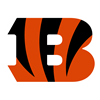 RB Joe Mixon
RB Joe Mixon
Let's compare Mixon to Dalvin Cook, who tends to see more targets and also is a superior runner. Cook has the higher ceiling, and he showed it in 2019 and 2020 despite missing a pair of games both years. The downside? Cook has missed 2.0 more games per season since he and Mixon entered the league in 2017, with recurring shoulder problems amplifying the risk.
Mixon missed 12 games with a foot injury in 2020, but he's otherwise played at least 14 games each year, including 16 in 2019 and 16 last season (with the only absence being non-injury-related in Week 18). Locked in as the lead back in a good offense with an improved line, Mixon might be the safest RB pick around the 1/2 turn, if not the most exciting. It's still hard to draft him over Cook, but I always take Mixon ahead of D'Andre Swift, Aaron Jones, Saquon Barkley, Leonard Fournette — all of whom enter the year with some kind of concern (quality of team's offense, health, talented backup, out of shape) that doesn't apply to Mixon.
 WR Brandin Cooks
WR Brandin Cooks
Cooks reached 1,000 yards and five TDs six of the past seven seasons, without once topping 1,204 yards or nine TDs. Last year, he drew a career-high 134 targets and finished with a career-low 7.7 YPT (still good work in a bad offense, especially with a 67.5 percent catch rate). Expect more of the same this year with Davis Mills throwing to essentially the same group of receivers (Cooks, Nico Collins, Chris Conley and TE Brevin Jordan).
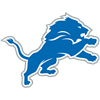 WR DJ Chark OVER Jameson Williams
WR DJ Chark OVER Jameson Williams
Both guys tend to go in the Round 12/13 range, with the hope that some big plays downfield can make up for uneven production throughout the season. Of the two, Chark is much more likely to be something approaching consistent throughout the year, if only because he's not a rookie rehabbing an ACL tear suffered in January. Reports suggest Chark has made a full recovery from the ankle fracture that ended his final season in Jacksonville after four games, while the Lions placed Williams on the non-football injury list for the start of training camp
 TE Tyler Higbee
TE Tyler Higbee
Higbee memorably had five straight games with at least 84 yards to close out the 2019 season. Since then, he's failed to reach even 70 yards in 35 consecutive games, including playoffs, yet still provided some value as a TE2 with back-to-back seasons of 500-some yards and five TDs (in 2020 and 2021).
While the weekly upside we saw late in 2019 was a mirage, Higbee's job security and age (29) suggest he's in line for similar production this year. He's a solid TE2 in cash games, while I'd rather roll the dice on a younger, faster guy like David Njoku or Noah Fant in tournaments.
Others
 QB Matt Ryan - job security, decent team, no rushing stats
QB Matt Ryan - job security, decent team, no rushing stats
 QB Mac Jones - ditto
QB Mac Jones - ditto
 RB Ezekiel Elliott - big plays rare; guaranteed touches, but so is his backup
RB Ezekiel Elliott - big plays rare; guaranteed touches, but so is his backup
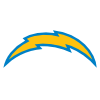 WR Keenan Allen - safe pick at 2/3 turn
WR Keenan Allen - safe pick at 2/3 turn












